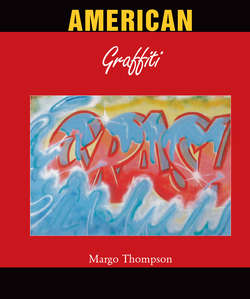Читать книгу American Graffiti - Margo Thompson - Страница 10
На сайте Литреса книга снята с продажи.
Subway Writers
Lettering and Style
ОглавлениеWriting was progressive: beginning in 1971, it evolved from simple tags, to big, colourful bubble and block letters, to the nearly illegible wild-style calculated to impress other writers. Writers graduated from perfecting the combination of letters that constituted their tags, to designing entire alphabets.[49] Individual writers recapitulated this evolution in their careers: the writing community expected them to understand the styles that surrounded them before contributing their own.[50] The possibilities for invention were endless, in PHASE 2’s estimation: ‘You can’t put a limit on communication or how one can communicate, you’ve always got to look further, that’s how style expanded in the first place’.[51] VULCAN expressed a similar sentiment: ‘Getting complicated, doing the impossible… I try to come up with new things that I’ve never seen before’.[52] There is a logic to writing that tends more towards elaboration than refinement, but nevertheless advances by way of a critical process in which the writers vocally participated.
DONDI was highly regarded for his inventiveness in designing tags, from legible block to intertwined wild-style letters. In a train he painted with KEL in 1979, they responded to an impressive piece called 2 MUCH + BOND by the TMT crew. DONDI wrote under the tag 2 MANY: the numeral 2 connected to the M, the N tilted into the Y that looked like an X (as DOC observed later). The legs of the letters bent in unexpected directions, folding in or shooting out. KEL mixed upper- and lower-case letters, and the lower bar of his L zigzagged into an arrow. In both pieces, the letters were decorated with spots of colour that contributed to the effect of fragmentation and made it difficult to discern the letter shapes. A scroll to the right at the end of the car declared, ‘We did it again’.[53] The elaborate, nearly illegible pieces were clearly meant as a challenge to other writers: DONDI and KEL’s CIA were the new writers to beat. Elsewhere, DONDI appealed to the general public with his three ‘Children of the Grave’ trains, where his tag was crisply rendered in big block letters and the title evoked the desperation of young men’s lives in the city. DONDI deliberately chose among the styles he had mastered when he designed his pieces, which proves his fluency as a writer and suggests his awareness of two distinct audiences.
Writers like DONDI were able to tune their styles to address different viewers. To use wild-style militated against outsiders understanding the content of the piece, because it was neither fully legible nor merely decorative or abstract. It competed with the desire to achieve fame in mainstream culture that is evident in some of the themes that I have described above. Instead, wild-style represented ambivalence towards mainstream society and put off subway riders. According to LEE,
The subway riders felt very intimidated and provoked by the whole evolution of wild-style in the mid-70s. Because it wasn’t readable any more. It felt foreign, they were alienated, and yet they were riding with it, to work every day. They felt that they were riding in something that they couldn’t understand anymore, and that scared them.[54]
It also expressed the way writers felt disadvantaged, said DOZE: ‘Graff [writing] is my ghetto defense. It’s my weapon against my sense of helplessness. It’s a code that is for us, for other graffiti artists to understand’.[55] LEE said,
There was a need among writers to come out with devastating paintings. Without money in your pockets, or any future in sight, there was a determination to create devastating work. One of the ways to vent that was through wild-style painting. You wanted to become a secretive figure that felt powerful by being anonymous, and being unreadable, and you felt dangerous like that.[56]
Through writing, young men and women built a subculture in which their class and racial identities had no effect on their efforts to gain fame and respect. Even as they inserted themselves visually into the public sphere, they controlled access to their world by adjusting their style.
DONDI, ASIA tag, 1981. Aerosol paint on New York subway car. Destroyed. Photo by ZEPHYR.
49
Austin, 111–13.
50
Cooper and Chalfant, 22.
51
Austin, 114.
52
Austin, 173.
53
Witten and White, 64–5.
54
Miller, 87.
55
Miller, 84.
56
Miller, 86.
